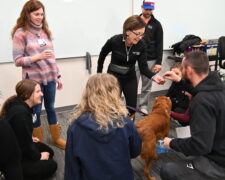Bellin College stages disaster training simulation to teach students interprofessional education
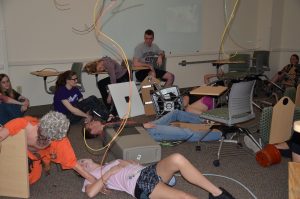 On Thursday, April 19, Bellin College staged a disaster simulation in the health sciences resource center (HSRC) in the lower level of the College. The simulation included students in the Bachelor of Science in Nursing (BSN), the Bachelor of Science in Radiologic Sciences (BSRS) and the Bachelor of Science in Diagnostic Medical Sonography (BSDMS) programs, and medical students from the Medical College of Wisconsin-Green Bay. The simulation also included assistance from healthcare providers from various local hospitals and Bellevue Fire & Rescue. The area was transformed to create an environment of the aftermath of a school fire. Students played the role of victims/patients and others as the healthcare providers. Areas of care were categorized (black, red, yellow, and green) based on the condition of the patients.
On Thursday, April 19, Bellin College staged a disaster simulation in the health sciences resource center (HSRC) in the lower level of the College. The simulation included students in the Bachelor of Science in Nursing (BSN), the Bachelor of Science in Radiologic Sciences (BSRS) and the Bachelor of Science in Diagnostic Medical Sonography (BSDMS) programs, and medical students from the Medical College of Wisconsin-Green Bay. The simulation also included assistance from healthcare providers from various local hospitals and Bellevue Fire & Rescue. The area was transformed to create an environment of the aftermath of a school fire. Students played the role of victims/patients and others as the healthcare providers. Areas of care were categorized (black, red, yellow, and green) based on the condition of the patients.
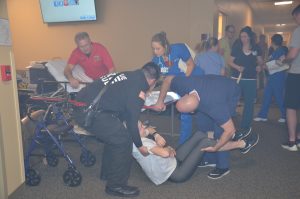 “This type of training gives students the opportunity to work together in a collaborative approach during a life-like simulation, and helps them ensure they are effective communicators among all disciplines in the hospital setting,” said Ashley Hall, Health Sciences Resource Center Simulation Coordinator at Bellin College.
“This type of training gives students the opportunity to work together in a collaborative approach during a life-like simulation, and helps them ensure they are effective communicators among all disciplines in the hospital setting,” said Ashley Hall, Health Sciences Resource Center Simulation Coordinator at Bellin College.
Overview of the simulation scenario:
A group of people were at a conference at a local school when a fire starts. The power went out in the lab area. Multiple people were injured. There were approximately 30 to 45 patients, but the exact count was unclear at the time. Some victims escaped and are at a safe place across the street. The area was cleared and determined safe by the fire department. The goal for the students was to safely evacuate the injured individuals to the appropriate area, and provide appropriate interventions based on their assessment, the injuries and needs of each patient. The fire department/EMS were onsite to help and assist students in triaging, evaluating, and safely transporting patients to the designated area.
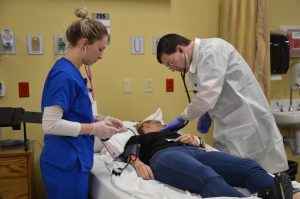 Why Bellin College teaches interprofessional education (IPE) simulation:
Why Bellin College teaches interprofessional education (IPE) simulation:
There is a growing emphasis on interprofessional education (IPE) among the health profession. This movement is supported by research on teamwork and communication within the healthcare delivery system, which reports that miscommunication and poor teamwork results in medical error and poor patient outcomes. The move toward interprofessional education (IPE) and interprofessional collaboration (IPC) will strengthen health systems and improve health outcomes and has led to the development of interprofessional core competencies to be taught within health professional educational programs.
Main objectives for students to learn from this simulation include:
- Appreciate the importance of interprofessional communication
- Demonstrate effective use of knowledge, skills and abilities to provide patient care safely
- Collaboratively implement interventions based on assessments and priorities
- Identify the value of partnerships in the provision of quality patient care
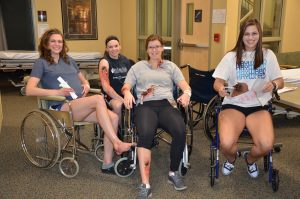 “Although this drill was a simulation—it was very realistic. Having participated in a past simulation as a victim I feel I will be able to provide better care for my patients that have gone through a crisis. It was a humbling experience and although I wish I never have to be apart of one, I feel that simulation training has equipped me if I am ever put into a situation like this. I am grateful that Bellin College gives us opportunities at the school and within the community to better prepare us for the different situations we may be exposed to in the healthcare setting,” said Bellin College senior nursing student, Anna Weber.
“Although this drill was a simulation—it was very realistic. Having participated in a past simulation as a victim I feel I will be able to provide better care for my patients that have gone through a crisis. It was a humbling experience and although I wish I never have to be apart of one, I feel that simulation training has equipped me if I am ever put into a situation like this. I am grateful that Bellin College gives us opportunities at the school and within the community to better prepare us for the different situations we may be exposed to in the healthcare setting,” said Bellin College senior nursing student, Anna Weber.

